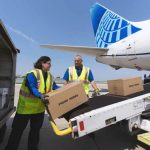Smiths Detection: Making air cargo security a top priority
By Ayesha Rashid
“The HI-SCAN 10080 XCT has been qualified under the US Safety Act, setting limited liability for claims related to terrorism. It is TSA certified for high-speed checked baggage screening and EU/ ECAC EDS Standard 3.0 and 3.1 as well as TSA ACSTL approved. Moreover, technology to detect dangerous goods such as lithium batteries as well as flammable solids and liquids, compressed and liquefied gases can be seamlessly integrated to enhance this scanner.” — Harald Jentsch, Head of Airports, Baggage Screening & Air Cargo Screening, Smiths Detection
 In the aftermath of the September 11, 2001 terrorist attacks, the importance of air cargo security has become increasingly apparent. Air cargo security involves a wide variety of procedures and practices designed to protect the cargo carried on commercial aircraft from terrorist attacks or other threats.
In the aftermath of the September 11, 2001 terrorist attacks, the importance of air cargo security has become increasingly apparent. Air cargo security involves a wide variety of procedures and practices designed to protect the cargo carried on commercial aircraft from terrorist attacks or other threats.
One important air cargo security procedure is known as ‘screening’ which refers to the process of inspecting cargo for explosives or other dangerous materials. Cargo screening may be carried out manually or using automated screening equipment.
Another key air cargo security procedure is known as ‘vetting’ which refers to the process of verifying the identity of the cargo’s owner and the legitimacy of the cargo itself. This involves checking the cargo against various databases of banned items and terrorists.
Air cargo security measures are also designed to prevent cargo from being stolen or from falling into the wrong hands. In order to achieve this, cargo is typically screened and sealed prior to being loaded onto an aircraft.
The global air cargo security and screening market was valued at $687 million in 2021 and is projected to grow at a CAGR of 9.0% during the forecast period 2022-2032 (Visiongain).
Harald Jentsch, Head of Airports, Baggage Screening & Air Cargo Screening, Smiths Detection, explains how there TSA certified product Hi-SCAN 10080 XCT is fully automated in screening and detecting air cargo threats at high speed.
Bomb detection
CT scanners were originally developed for medical applications, but were also first used for security scanners in the early 1990s. They are now increasingly being used in air cargo operations, especially when speed and efficiency are of utmost importance.
 The HI-SCAN 10080 XCT is a next generation high-speed, explosives detection system (EDS) for hold baggage and air cargo. It features a dual-view dual-energy X-ray line scanner with full 3D volumetric computed tomography (CT) imaging and reconstruction. The HI-SCAN 10080 XCT has a belt speed of 0.5m/sec (98.5ft/min) and a large 107 x 81 cm (42.1 x 31.9in) rectangular tunnel. It is designed to be integrated into fully automated and networked baggage and material handling systems. This combination offers airports a throughput of up to 1,800 bags/hour and air cargo handlers the capability to screen 2,500 parcels/hour.
The HI-SCAN 10080 XCT is a next generation high-speed, explosives detection system (EDS) for hold baggage and air cargo. It features a dual-view dual-energy X-ray line scanner with full 3D volumetric computed tomography (CT) imaging and reconstruction. The HI-SCAN 10080 XCT has a belt speed of 0.5m/sec (98.5ft/min) and a large 107 x 81 cm (42.1 x 31.9in) rectangular tunnel. It is designed to be integrated into fully automated and networked baggage and material handling systems. This combination offers airports a throughput of up to 1,800 bags/hour and air cargo handlers the capability to screen 2,500 parcels/hour.
“The HI-SCAN 10080 XCT has been qualified under the US Safety Act, which sets limited liability for claims related to terrorism. It is TSA certified for high-speed checked baggage screening and EU/ ECAC EDS Standard 3.0 and 3.1 as well as TSA ACSTL approved. Moreover, technology to detect dangerous goods such as lithium batteries (iCMORE Lithium Batteries) as well as flammable solids and liquids, compressed and liquefied gases (iCMORE Dangerous Goods) can be seamlessly integrated to enhance this scanner,” explains Jentsch.
The HI-SCAN 10080 XCT combines an X-ray line scanner delivering 2D images with 3D volumetric computed tomography (CT) imaging.
The line scanner uses X-ray to penetrate air cargo goods and measure the absorption, delivering detailed material discrimination.
The CT gantry rotates at a constant speed as the baggage or cargo is carried through it on a conveyor belt. It spins around the object taking hundreds of views at slightly different angles and then reconstructs the raw scan data into volumetric 3D images using measurements based on density.
The combined comprehensive data is used to make precise measurements and very accurate judgements on substances within the bag.
Scanning process
Typically, there are two ways to meet the latest regulations – conventional, often standalone, X-ray scanners which require 100% manual image analysis; or in-line, automatic explosives detection (EDS) systems with Computed Tomography (CT) technology which only require analysts at the recheck stage. Both will deliver compliance but, operationally, there are considerable differences with high speed, in-line CT solutions offering the best outcome.
“Working to small two-four hour windows, air cargo handlers need to move huge volumes as quickly as possible using material handling systems. Although historically, standalone, X-ray scanners have been used for air cargo screening, by nature they are restricted in terms of speed. Firstly, belt speeds average around 0.2m/sec and manual loading and unloading is required and, in addition, image analysis is 100% manual. High speed, fully automated equipment (like the HI-SCAN 10080 XCT) delivers higher throughput and greater operational efficiency which suggests there is a strong business case for investing in a more sophisticated solution.
“At the start of the screening process, an automatic evaluation is made by the scanner. If the system produces an alarm and further assessment is needed, the images are passed to an operator who can make a quick decision based on 3D images which can be rotated for a 360 degree view. Due to the high level of automated detection and low false alarm rates only a few images require any operator analysis or intervention which, of course, speeds up the process and optimizes staff resources.”
If the automatic explosives detection capability of a scanner produces an alarm, the image is passed on to an operator for evaluation. Suspicious items are highlighted, and the high-resolution 3D rotatable image enables operators to make quick and accurate decisions. Additional automatic dangerous goods detection algorithms can further support operators by drawing a frame around, for example, Lithium Batteries, Jentsch explained further.
Future threats neutralized
“With our suite of scanning software and technology, a wide range of aviation threats will be detected. We deliver the solutions needed to protect society from the threat and illegal passage of explosives, prohibitive weapons, contraband, biological threats, toxic chemicals and narcotics. Our goal is simple – to provide the security, peace of mind and freedom of movement upon which the world depends.
“The main security threat for Air Cargo in terms of screening is, similar to the whole aviation community, that from explosives (IEDs – improvised explosive devices) in general and particularly homemade explosives. Especially as terrorists are becoming increasingly sophisticated in developing and concealing them. It is worth noting that about 50% of air cargo is transported on passenger flights.”
From a safety point of view, the growing use of Lithium Batteries and other dangerous goods poses another risk to air cargo industry; statistics from IATA have shown a strong increase of risks due to Lithium Batteries which can cause safety risks in Airplanes when not accurately packaged or secured against shortcuts as then can cause heat/fire incidents.
In addition to these threats, the tremendous growth in network connectivity and digital data sharing exposes more and more organizations to cybersecurity threats.
Cybercrime and data breaches are on the increase and the protection against them is a priority for all stakeholders. From both a social and economic standpoint, the consequences of any violation is grave, putting a huge responsibility on companies and public administrations to prevent such breaches.
Accordingly, legislators are ramping up national safeguards and standardizing processes and regulations. By strongly evolving its capabilities, Smiths Detection is able to detect explosives substances beyond regulatory requirements.
With usage of machine learning (ML), convolutional neuronal networks (CNN) – or generally with artificial intelligence (AI) the security industry now has additional technology tools to identify threats. The human operator also represents an important stage of the detection process, as they will be responsible for differentiating between threats and false alarms.
Securing threats
There are many factors to consider when it comes to air cargo security. New standards are constantly emerging to help ensure a safe and secure transport system. Security must be present at every stage of the transport chain, from start to finish.
“Security does not only begin at the aircraft. Security permeates the transport chain from start to finish. From shippers over forwarders and airliners through to industry associations and authorities, all stakeholders in the transport chain are challenged to assure that air cargo worldwide is 100% subjected to the same thorough security checks.
“Smiths Detection equipment has been fulfilling and exceeding international legislative requirements for air cargo screening and is committed to further enhance the security chain with its comprehensive range of detection solutions. A close security chain is increasingly becoming an integral part and a hallmark of quality for global trade activities in the future. As mandated by the authorities, air cargo on passenger aircraft has to be security screened. As a world leader in transportation security, notably airport X-ray systems used in the search for illegal or dangerous items.”
According to Jentsch, Smiths Detection is well experienced in providing air carriers and other stakeholders in the security chain with cargo security technologies tailored to fit their layer of security and to meet their respective legislative mandate.
Smiths Detection air cargo screening systems are designed for screening loose, bulk, containerized or palletized configurations. Experience has shown that air cargo is very much heterogeneous, starting from air mail and small parcels up to standardized container units. Depending on the respective logistics different approaches for the inspection of freight have to be found.
Smiths Detection offers adequate concepts for all different scenarios. In addition, Smiths Detection also provides services for the operator training and maintenance of the air cargo screening equipment to fulfill high equipment availability requirements necessary to keep that industry running.
“Technology-based security systems and methods, from X-ray scanners to explosives trace detectors, ensure the most effective and efficient detection of threats (versus manual inspection). For an industry that trades on speed, it is essential to ensure the smooth flow of goods as well as protect the quality of time sensitive goods that could easily spoil,” Jentsch concludes our email interview.
Despite the importance of air cargo security, many experts believe that the current system is far from perfect. One major problem is that the screening process is often seen as being time-consuming and inconvenient. Additionally, the cost of implementing and maintaining air cargo security procedures can be prohibitive for some small businesses.
Nevertheless, the Transportation Security Administration (TSA) has made air cargo security a top priority, and new measures are being put into place all the time. In the coming years, it is likely that air cargo security will become even more important than it is today.














